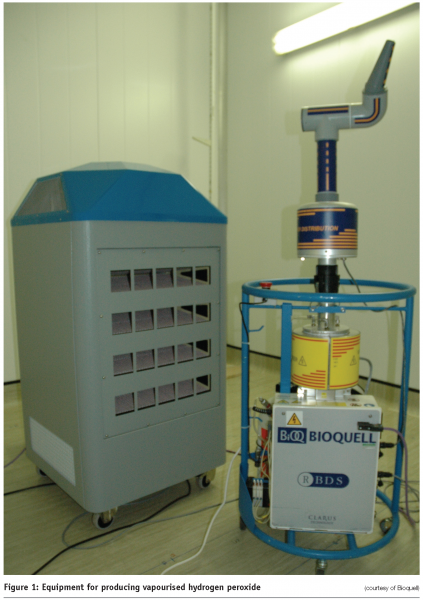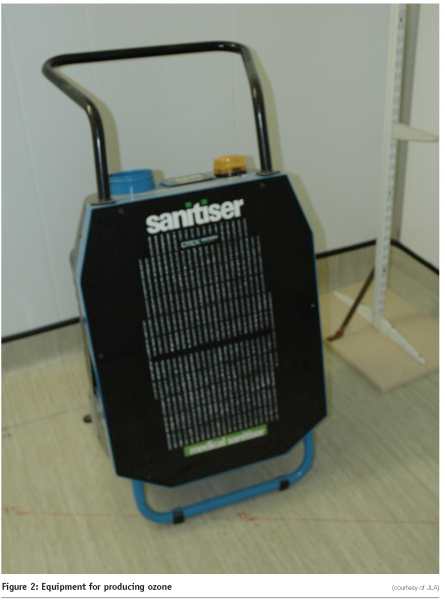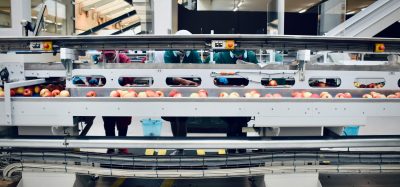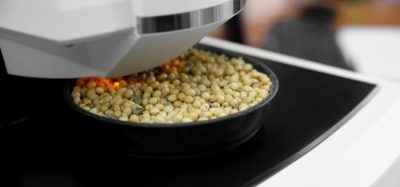Whole room disinfection: A new concept in food industry sanitation
- Like
- Digg
- Del
- Tumblr
- VKontakte
- Buffer
- Love This
- Odnoklassniki
- Meneame
- Blogger
- Amazon
- Yahoo Mail
- Gmail
- AOL
- Newsvine
- HackerNews
- Evernote
- MySpace
- Mail.ru
- Viadeo
- Line
- Comments
- Yummly
- SMS
- Viber
- Telegram
- Subscribe
- Skype
- Facebook Messenger
- Kakao
- LiveJournal
- Yammer
- Edgar
- Fintel
- Mix
- Instapaper
- Copy Link
Posted: 28 February 2008 | Dr. Karen Middleton, Technical Contracts Manager, Food Hygiene Department, Campden & Chorleywood Food Research Association, UK | No comments yet
During manufacture, food can be exposed to microbiological cross-contamination from surfaces and air which may give rise to food spoilage and safety issues. The traditional approach to controlling such contamination has been to target specific sites within the manufacturing environment with cleaning and disinfection regimes. The primary focus is typically on food production equipment and […]
During manufacture, food can be exposed to microbiological cross-contamination from surfaces and air which may give rise to food spoilage and safety issues. The traditional approach to controlling such contamination has been to target specific sites within the manufacturing environment with cleaning and disinfection regimes.
The primary focus is typically on food production equipment and much of the rest of the processing area is not routinely decontaminated. This targeted approach may have been sufficient to maintain day-to-day control of contamination, but has not eliminated the organisms responsible and in some instances, microbial strains have become persistent in food factories, surviving for several years. Previous research at CCFRA assessed the microbial flora of the high risk areas of five chilled food factories, all operating good practice cleaning and disinfection regimes, and identified persistent strains of Listeria spp. and Escherichia coli that had remained in the processing environment in excess of three years1,2. Clearly, if there was any loss of hygiene control in these factories, these organisms would always be present and thus could present a constant risk to product safety.
There is therefore now a desire to supplement traditional, targeted chemical disinfection with alternative approaches which will control the processing area in its entirety; a technique that can be termed as ‘whole-room’ disinfection. Both the pharmaceutical and clinical sectors have been targeted by a range of ‘whole-room’ type decontamination systems including UV, UV/titanium dioxide, ozone, hydrogen peroxide and ionisation but these techniques have had little assessment and their practical operation and benefit in the food and drink industry is relatively unknown.
CCFRA have a three year member funded research project which aims to provide guidance to the food and drink industry on the range of decontamination systems available, their selection and their use for whole-room disinfection procedures. Through this research, it is anticipated that the following questions will be answered:
- Which decontamination techniques are applicable to the food industry?
- Of the organisms that are a potential issue in the food processing environment?
- Which can be controlled by these techniques?
- How effective are the techniques?
- What methods should be used to validate the techniques?
- What type of areas can the techniques be applied to?
- How many decontamination units are required per given area?
- How long will it be before the persistent micro-organisms return?
- How often should whole room disinfection procedures be carried out?
- What are the health and safety aspects to consider?
- What will be the effect of these decontamination techniques on the fabrication of the application area?
- Will any disinfectant residues affect the organoleptic quality of subsequent food products?
- How long after the decontamination procedure can production start?
The initial stages of the project have involved identifying commercially available decontamination systems, which could be used for whole room disinfection of food production areas. Through liaising with equipment suppliers and literature searches, information has been obtained on how these techniques work and how they could be used in the industry.
Decontamination methods for whole room disinfection
Applying chemical disinfectants to production areas as fogs or mists is a method that has been used routinely in the food industry to control cross contamination from microbial aerosols. The technique is most effective using compressed air-driven fogging nozzles producing particles in the range of 10 to 20 micron range. Disinfectants that can be fogged in food processing environments include quaternary ammonium compounds, amphoterics and peracetic acid. For whole room disinfection, fogging is only effective if sufficient chemical is deposited onto all of the surfaces, but research has shown that the greatest effect is on the air and horizontal surfaces, with minimal effect on vertical surfaces and underneath equipment. The procedure can be improved with the use of electrostatic fogging nozzles, which help ensure a greater surface coverage of the aerosol droplets, even on non-horizontal surfaces. Chemical fogging can also be an issue if electrical items are located in the area being disinfected.
Fumigation with vapourised hydrogen peroxide (VHP) is a technique that has been widely used for disinfection in the pharmaceutical environment, including production filling lines, sterility testing areas and production facilities and may be an alternative to fogging for the food industry. The application is dry, so there are no issues with the presence of electrical equipment and the vapour is able to penetrate the whole room. An example of the type of equipment required for this procedure can be seen in Figure 1 on page 70. A typical decontamination cycle consists of four phases in a one step process. The phases are: dehumidification, to reduce the relative humidity to less than 40%; conditioning, where the hydrogen peroxide is vapourised; decontamination, which consists of a steady injection and re-circulation of the VHP to maintain the concentration, typically 0.1 to 3.0 mg/L, for the desired exposure time; and aeration, where the residual vapour is catalytically decomposed into water vapour and oxygen3. Overall, decontamination times will depend on factors such as the VHP concentration and the temperature of the environment but they are generally in the order of 2 to 4 hours. It should be noted that micro-organisms classified as catalase positive may be more resistant to disinfection by low concentrations of hydrogen peroxide.
Another gaseous disinfectant to consider for whole room disinfection is ozone. This chemical has been used for decades for water treatment, as it inactivates a wide range of micro-organisms, but the benefit of using ozone in the food industry is that it is environmentally friendly, with any residual ozone spontaneously decomposing to oxygen. Portable ozone generators are now available and have discharge units and fans to create the ozone at concentrations between 0.05 and 5 ppm and catalytic converters to convert ozone to oxygen, at the termination of the exposure period. An example of this type of equipment can be seen in Figure 2.
Vapours and gases have several advantages as they can effectively penetrate every part of a room, including sites that might prove difficult to gain access to with conventional liquids and manual disinfection procedures. The major disadvantage of using gases is their potential toxicity at high concentrations, which precludes using them in areas where people are working and they can therefore only be used in rooms that can be sealed off or quarantined for the duration of the treatment.
The use of UV light as a method of water disinfection has been researched extensively but equipment has now been designed to apply the technique for disinfection of surfaces and the air. Conveyor belt systems and barrier tunnels have been developed to enable disinfection to be carried out on surfaces where a dry chemical-free disinfection method is required. The UV light in the range of 185 – 400nm, also known as UV-C, has been shown to be antimicrobial, with the optimum wavelength at 265nm. The UV-C is generated by either low or medium pressure lamps and the dosage required, measured in mJ/cm2, will be dependent on the microbial contaminant, with fungal spores requiring a higher dosage than vegetative bacteria. The advantage of using UV light is that the environmentally friendly technology can be applied to a whole room but there can be issues with shadowing, as the contaminants need to pass through the light field to be inactivated.
Equipment has also been developed to disinfect air by a process termed as ionisation. Air is passed over an ionising tube, which produces positively and negatively charged ions, and clusters of oxygen ions are formed. These ions attract the naturally charged airborne micro-organisms, bonding with them and removing them from the air where they are deposited onto special grounded collectors on walls and floors. There is now the possibility of developing this technique further to treat surface contaminants, as well as airborne micro-organisms4.
Surface coatings, based on nanotechnology, have also been developed to make surfaces easier to clean or self-cleaning. Titanium dioxide is one coating that has been shown to demonstrate two photo-induced responses. The first is a photocatalytic response that is activated by the presence of UV light and the second is a superhydrophillic response which reduces the surface tension of water on the surface and improves cleanability5.
Laboratory assessments
The next stage of the research has been to develop methods to ensure that such decontamination systems, under assessment, cover the whole room. A suitable laboratory testing facility has been established to assess decontamination of all exposed room surfaces, such as the ceiling, walls, floors, equipment and practical methods have been developed based on the surface disinfectant test BS EN 13697: 20016. The method involves inoculating stainless steel discs (2 cm diameter, Grade 2 B) with 0.05 ml of a 108cfu ml-1 microbial test suspension and drying the discs at a temperature of 37°C for approximately 1 hour. The discs are then attached to metal stands within the room at horizontal, vertical and ‘underneath’ orientations. After treatment, the discs are aseptically transferred into sterile containers containing 5g sterile glass beads, 9ml diluent and 1ml inactivator and the containers agitated on a horizontal surface for 1 minute to recover the bacteria into suspension. Validation with spore strips has been carried out to ensure that the equipment under trial is sufficient to decontaminate all surfaces within the laboratory, i.e. to ensure any ‘failures’ were due to poor disinfection rather than poor coverage. Further work may assess the penetration into equipment and determine the level of airborne disinfection.
Field trials
Factory demonstration trials will also be carried out to evaluate the suitability of the successful methods for factory use. This will involve assessing health and safety aspects, compatibility with factory fittings, removal of the disinfectant prior to production and taint and toxicity issues. Work will also be carried out with the equipment and food manufacturers to calculate the decontamination coverage i.e. how many units are required per given area. From this data, evidence will be collated to determine the potential of these techniques to reduce and minimise contamination in the food processing environment. Information will also be gained on the long term effects of using these techniques on micro-organisms and the environment.




References
- Holah, J., Bird, J. & Hall, K. (2002) The microbial ecology of high risk, chilled food factories; evidence for persistent Listeria spp. and Escherichia coli strains. R&D Report No.165, Campden & Chorleywood Food Research Association.
- Holah, J., Bird, J. & Hall, K. (2004) Listeria monocytogenes and Escherichia coli in high risk, chilled food factories; where do they come from? R&D Report No.199, Campden & Chorleywood Food Research Association.
- McDonnell, G., Grignol, G. & Antloga, K. (2002) Vapor phase hydrogen peroxide decontamination of food contact surfaces. Dairy Food and Environmental Sanitation, 22(11), 868-873.
- Arnold, J.W. & Mitchell, B.W. (2002) Use of negative air ionisation for reducing microbial contamination in stainless steel surfaces. Journal of Applied Poultry Research, 11, 179-186.
- Maatta, J., Piispanen, M., Kymalainen, H.R., Uusi-Rauva, A., Hurme, K.R., Areva, S., Sjoberg, A.M. & Hupa, L. (2007) Effects of UV radiation on the cleanability of titanium dioxide coated glazed ceramic tiles. Journal of the European Ceramic Society. Article in press.
- BS EN 13697:2001 – Chemical disinfectants and antiseptics- Quantitative non-porous surface test for the evaluation of bactericidal and/or fungicidal activity of chemical disinfectants and antiseptics used in food, industrial, domestic and institutional areas.









